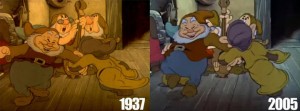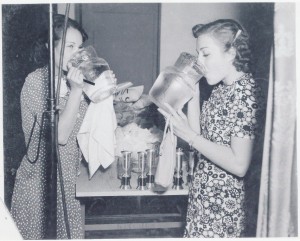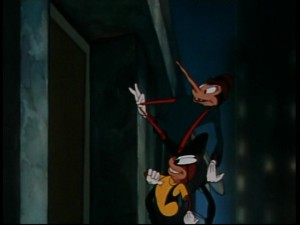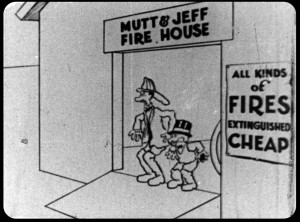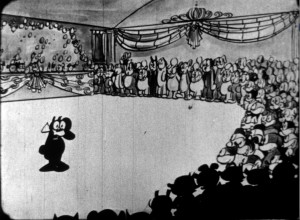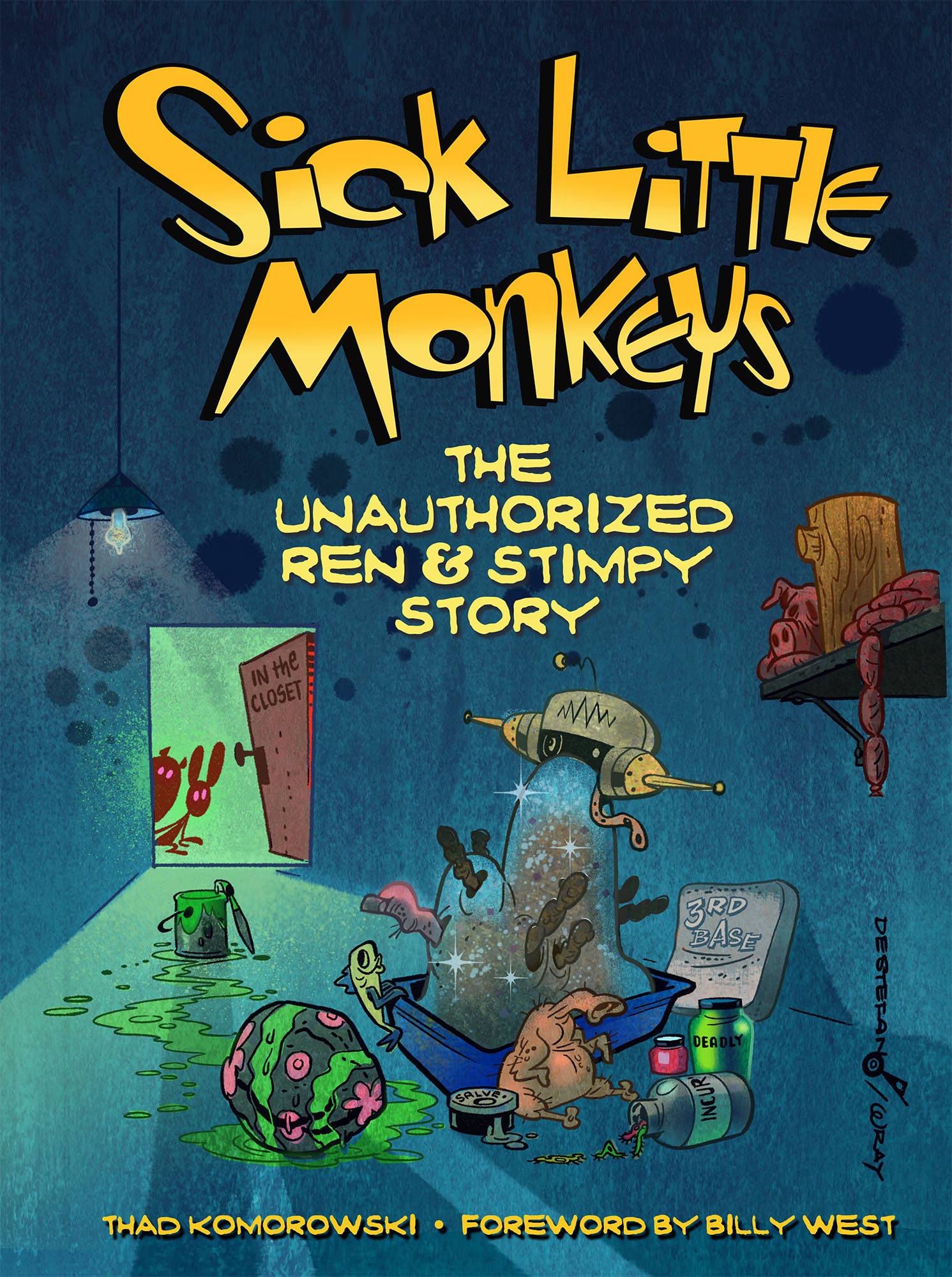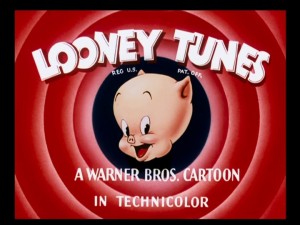 Thanks to historian and voice artist Keith Scott for providing me with some incredible research material that has allowed me to fill in many holes in The WB Production Number Project. The near entirety of the production numbers for the 1944-49 release seasons is now present and accounted for. I’ll have more to say on Warner cartoon trivialities in the coming months, thanks largely to Keith, who also keeps pushing me to write a book on the studio. Hmmm.
Thanks to historian and voice artist Keith Scott for providing me with some incredible research material that has allowed me to fill in many holes in The WB Production Number Project. The near entirety of the production numbers for the 1944-49 release seasons is now present and accounted for. I’ll have more to say on Warner cartoon trivialities in the coming months, thanks largely to Keith, who also keeps pushing me to write a book on the studio. Hmmm.
Category Archives: classic animation
Excessive, Isn’t He?
Filed under classic animation
McKimping
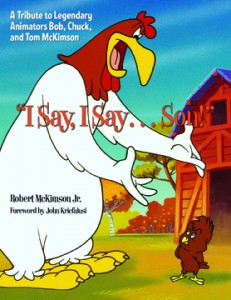 In the other corner of animation history, there have been many books about the Warner Bros. cartoons as a whole, but few bely the term “vacuous”, and even fewer examine individual figures. Certainly a book about Robert McKimson, a key player in the Termite Terrace legacy, has never been considered, which is why I Say, I Say … Son! : A Tribute to Legendary Animators Bob, Chuck, and Tom McKimson is sparking curiosity. Penned by Robert McKimson, Jr., the book “details how his father Bob McKimson created such beloved characters as Foghorn Leghorn, the Tasmanian Devil, Sylvester Jr., and the original Speedy Gonzales, and explores Chuck and Tom McKimson’s voluminous body of work at Warner Bros. Cartoons, Dell Comics, and Golden Books.” (From the press release sent out by Santa Monica Press.)
In the other corner of animation history, there have been many books about the Warner Bros. cartoons as a whole, but few bely the term “vacuous”, and even fewer examine individual figures. Certainly a book about Robert McKimson, a key player in the Termite Terrace legacy, has never been considered, which is why I Say, I Say … Son! : A Tribute to Legendary Animators Bob, Chuck, and Tom McKimson is sparking curiosity. Penned by Robert McKimson, Jr., the book “details how his father Bob McKimson created such beloved characters as Foghorn Leghorn, the Tasmanian Devil, Sylvester Jr., and the original Speedy Gonzales, and explores Chuck and Tom McKimson’s voluminous body of work at Warner Bros. Cartoons, Dell Comics, and Golden Books.” (From the press release sent out by Santa Monica Press.)
The book features a foreword by John Kricfalusi and an introduction by Darrell Van Citters. Kricfalusi’s is, of course, more anecdotal than anything else but still entertaining, and Van Citters delivers a curt, satisfying explanation of Bob McKimson’s importance in Warner animation. (Although he is incorrect to say McKimson “often animat[ed] substantial portions of his films.” It wasn’t “often”, only in the severe circumstance of McKimson’s unit getting laid off in the first half of 1953 before he was. He animated all of The Hole Idea by himself, as well as the majority of Dime to Retire and Too Hop to Handle; the latter two had animation by Jones animator Keith Darling.)
If only the actual, first-person text expressed a similar combination of John K.’s enthusiasm and Van Citters’s authority. While Robert McKimson, Jr.’s writing contains no substantial errors to my knowledge, keen insight into what made his father tick as an artist or director is alarmingly absent. Rather, it’s largely a potpourri of “fun facts” that almost every serious student of the Warner cartoons already knows from just watching the films. Quite a lot of the information is ostensibly based on Michael Barrier’s 1971 interview, and the wording and sentence placement is often random.
There are hints at where this book could have gone with the biographical information McKimson provides. The McKimson brothers’ father, Charles Sr., encouraged them to pick a career very early and develop work ethic, regardless of whether they chose a different vocation later. It obviously made a life-lasting impression on the artists. Robert and Tom McKimson were among the few Warner alumni who received formal art education before they got into animation. On their first day at Harman-Ising, Robert and Tom arrived at their desks precisely at 8 o’clock and proceeded turning out more footage than anyone else at the studio. “Consummate professional,” that oh-so-archaic endorsement, applied to all three of the McKimson artists from the very beginning, and I think that outlook shaped their artistic styles, particularly Robert’s, in a way that’s fascinating enough for a formal telling.
Robert McKimson was, self-admittedly, also a sort of pawn in studio politics; a candidate for director, like Art Davis, that Chuck Jones and Friz Freleng encouraged so there would be a less emotional personality in the studio intelligentsia. When Warners resumed normal operations in January 1954, all of Jones and Freleng’s crew eventually returned, and McKimson’s did not. McKimson’s wife also predeceased him by more than a decade as he continued to direct, and he “never quite got over it,” as his son writes. These events are certainly demoralizing to any working person, and a careful examination might have painted a more intimate portrait of a seldom discussed talent.
The text is also surprisingly lacking regarding the other brothers. Chuck McKimson is almost entirely absent from the book. Certainly none of his work for Pacific Title is included, which was specifically mentioned in advertisement for the release. The coverage of Tom McKimson’s work for Western Publishing is too sweeping and focuses almost exclusively on his drawings for children’s story and coloring books. As we’re reminded, Tom McKimson had enormous responsibility as Western’s art director beginning in 1948, but we’re given no indication of what his working relationships with the other (and in some cases, far more important) artists were like. It’s also a pity David Gerstein or I weren’t consulted, as I would have been happy to provide comic book scans of several beautiful covers and choice pages that Tom illustrated (including non-Warner characters). As a result, the inclusion of Chuck and Tom McKimson seem to be almost afterthoughts to the larger story of Bob McKimson’s work.It is an art book, so what matters largely is the art, and if it warrants the higher price tag such tomes demand. Is it good and is the art presented well? The answer is largely yes. A few drawings were obviously sourced from low-resolution scans (hence heavy pixilation), but that hardly matters when there are hundreds perfectly illustrated.
I learned and reflected more just by gleaming at the original vintage artwork than I did from the writing. Art for a proposed children’s book entitled Mouse Tales shows that Tom and Robert McKimson had the Disney style down peg before the studio did (and by association, they established the Harman-Ising studio’s style before it even existed). The tale of the ill-fated Romer Grey Binko cartoons is recounted with appropriate briskness and enticing drawings.
While the 1930s Schlesinger work by the McKimsons is all but unrepresented, fans of the glory Warner years need not worry. There are some great layout, animation, and model drawings from Robert and Tom McKimson’s years with Bob Clampett, emphasizing their role as significant foundation for those important films.
Robert McKimson’s tenure as a Warner director is the period represented heaviest by vintage art, including his infamous layouts that a great many of his animators reportedly found insufferable. (A whole scene from Of Rice and Hen is reproduced.) The key difference between McKimson’s methods and Jones’s as a director-character layout artist is that while both of their three-hundred drawings per cartoon are technically perfect for animation, McKimson’s simply aren’t expressive for filmmaking purposes the way Jones’s are. They discourage the kind of interplay and the proclivity for acting Jones’s animators enjoyed, the same kind Clampett encouraged when he was directing both McKimson and Rod Scribner. When the studio reopened, McKimson’s cartoons were populated by largely incompetents (save Warren Batchelder, a former assistant to Virgil Ross) who had no choice but to follow the layouts strictly as given to them. It cost McKimson’s last decade of directing at Warners any rambunctiousness, but at least it spared a Scribner, Emery Hawkins, Bill Melendez, or Manny Gould from getting stifled.

A scene from Fool Coverage, released in 1952. Robert McKimson layout left (scan from the McKimson book), finished scene from the film (obviously by Rod Scribner) right.
The book is heavily illustrated with a lot of “Limited Edition” art either drawn by the McKimson brothers, based on their original drawings, or recreations of scenes from the McKimson-directed Warner shorts by other artists. This isn’t as problematic as it sounds, because unlike the Freleng studio art (gangly creations that were only painted and not drawn by him) or the ghastly Jones deformations, the McKimsons’ waning art is genuinely pleasant to look at, and brought a smile to my face several times.
Actually, just about every page brought a smile to my face. Not purely because of nostalgic recollections of watching the cartoons endlessly on television as a child, or the waves of funny moments with Bugs, Daffy, Sylvester, and Foghorn that still make me laugh today. It’s because the art is mostly just so damned good. There is a proficiency and humbleness to the McKimson wavelength that makes it unwaveringly appealing, the exact thing sorely lacking from so much Hollywood animation in the last half-century. Criticism of McKimson’s direction will never die in animation circles, but ultimately, the man’s biggest crime was having a role in originating the look of some of the most beloved fictional characters ever created, shaping the animation style of the greatest animated films, and turning out a couple dozen really funny cartoons. I don’t think McKimson Jr.’s writing will convert any non-believers, but the presentation of the artwork might convince folks that few classic or modern Hollywood animators have succeeded where McKimson failed. That alone makes the book worth a purchase.
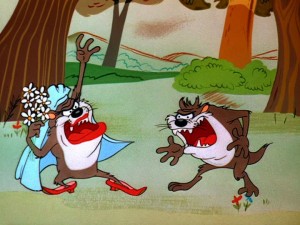
Filed under classic animation, people
The Beauty of the Walled Garden
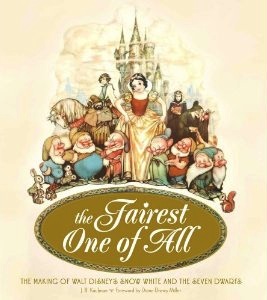 Whenever the latest one comes out, I always ask myself: how many books on the subject of Disney do we really need?
Whenever the latest one comes out, I always ask myself: how many books on the subject of Disney do we really need?
The Disney Company seems to be increasing the amount of books pumped out about its history every year, and the answer to why is simple: few other Hollywood studios have kept as pristine records as Disney has, giving the company an unprecedented advantage on the book market. It of course also continues to establish the Disney Way over other styles of animation. Big attractive, lusciously illustrated books about Disney abound, and the ones about other films keep shrinking.
More importantly, they are also ingenious at keeping readers satisfied with no more than they “need” to know. (For an excellent examination of this topic, read Michael Barrier’s piece, “The Approved Narrative.”) I commend anyone with the dexterity to undertake such a project, given how increasingly paranoid the corporate behemoth is getting these days. (Re: the delay of Amid Amidi’s Ward Kimball biography.)
I met J.B. Kaufman in 2009 at the Buffalo International Film Festival, where he was a special guest promoting his newly released South of the Border. From meeting him personally and reading his work, he strikes me as someone with an earnest appreciation of the medium’s history and one of the few able to communicate it through his writing. He told me that while he enjoyed learning everything he did and found South a rewarding experience, he was far more thrilled to start working on his new book about Snow White and the Seven Dwarfs.
We should all share his enthusiasm. The Fairest One of All: The Making of Walt Disney’s Snow White and the Seven Dwarfs is possibly the most welcome of all Disney Editions in recent years. With access to seemingly endless documentation, Kaufman was able to create a much-needed work: the go-to-book for the most written about and lauded animated feature.
As I’ve stated before, Snow White was not one of my favorite Disney features growing up. Its clunkiness and overlong nature was too obvious, and I was swayed by the later features’ slicker surfaces and broader comedy. Upon revisiting it several times on actual film, what resonated with me considerably more than the best acting scenes by Bill Tytla and Fred Moore was how convincingly the artists portrayed mood throughout the picture, specifically pure horror. All but a scant few pictures in this genre defy the classification of camp, but for a period of time Disney was able to get under people’s skins and emotions like few other filmmakers.
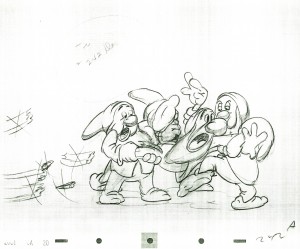
From a Bill Tytla scene, drawing appropriated from Michael Sporn’s Splog.
None of this is addressed in the book, and it of course shouldn’t be, given its topic. It’s a mark of its strength that it’s gotten me to ponder about Disney so deeply. There is a lingering problem in the text though, which I also noticed in South of the Border. Kaufman seems to be holding back, balancing positivity and negativity far too evenly. The “now it is bad, but there are some virtues” template is used far too often for any serious critical discourse to be established, probably exactly what Disney Legal had in mind. It also works in its disfavor when there clearly is a right answer, as with the far too wishy-washy coverage of the color and restoration issues with Snow White over the years. There clearly is a right way to see the film, and that is how Walt Disney delivered it to RKO in 1937. (A frame grab comparing a frame from an original 35mm nitrate to the modern DVD is below, exemplifying how the initial candlelight effect of the cottage interior has been eradicated over the years.) At the very least it should be released in that incarnation some way, let the naysayers say what they will.
Even under these conditions, Kaufman plants analyses successfully throughout the text, so that a less enlightened reader might be convinced that the animation in The Goddess of Spring is seriously bad, or that all of the Disney heroines from Cinderella on are unquestionably simpler in conception than Snow White. His fervor for the film is evident on every page. Even the seemingly most mundane aspects about the feature are brought to entertaining life. Kaufman’s writing is not condescending, free of academia, and sympathetic to an accurate portrayal of an important period of Disney history.
The biggest downside to this book is the utter lack of actual animation drawings, made all the more noticeable by how scrumptiously displayed the rest of the artwork is. Perhaps there was conflict using similar illustrations to those seen in the backhanded Illusion of Life. But considering how excessively detailed Kaufman’s descriptions of the contributions Tytla, Moore, Babbitt, Natwick, et. al. made to the film, what better place to show their actual drawings?
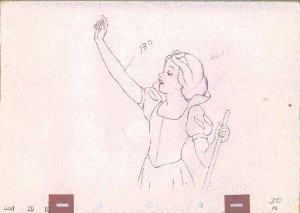
From a Grim Natwick scene.
Everything that went into making this film, be it the story meetings, the lectures from Walt, or the sheer labor in actually drawing the thing, makes for some of the most compelling writing on animation ever. Writers try to make the behind-the-scenes stories of other Disney films seem just as intriguing, but they almost never are, most likely because the hard part, actually making a watchable 80-minute cartoon feature, was already accomplished. Everything that followed after was just business as usual for the artists, thus most of the later films were never as compelling, and the studio was just fine with that. Yes, the “sincerity” remained there for awhile, but it had all but vanished by the turn of the war; certainly it’s nonexistent in today’s meaning of “Disney”. Whether anyone will actually admit that is unlikely. But Kaufman’s book is at least a reminder of the assets when sincerity in filmmaking is actually, well, sincere.
Filed under classic animation, classic movies
Moving Forward, Looking Back
Like everyone else in the animatophile community, I spent my Sunday night by not watching the Seth MacFarlane block on FOX, but the block of classic animation on Turner Classic Movies, co-hosted by the patron saint of animation, Jerry Beck. Actually, those shows were cancelled in favor of baseball, so perhaps ratings for TCM got a boost.
Starting the block were the only two animated features of the Golden Age that weren’t made by Disney, the Fleischers’ Gulliver’s Travels and Mr. Bug Goes to Town. The transfer of Gulliver was incredibly weak and muddled with the DVNR process. Along with having its original title reinstated, Mr. Bug looked beautiful. I’m very familiar with the 35mm nitrate from the Museum of Modern Art they used, and it’s delightful that everyone was able to see that genuine, raw 1941 Technicolor for themselves.
If only either of them were truly great films though! What I get from both of the Fleischer movies is an overwhelming sense that the animators just didn’t want to make the damn things. You don’t need to read J.B. Kaufman’s excellent new book on Snow White and the Seven Dwarfs (which I will be reviewing shortly) to know that that film is the product of a man with an obsession, backed by a fleet of artists determined to do their part in realizing it.
The polar opposite is true of Gulliver’s Travels, an almost willfully convoluted film on every level. The Fleischer studio simply tried in vain to be something they weren’t. There are some very elaborate sequences, but they are smothered by overlong stretches of needless exposition and shameless forgeries from Disney’s first picture. It’s said that one possible route early in development was to feature Popeye as Gulliver, and it’s so easy to envision a richer film evolving out of that concept. Sadly they didn’t, and we have the very poor film that launched TCM’s animation celebration.
Perversely, the second Fleischer feature, Mr. Bug Goes to Town, tanked, even though it’s a vast improvement over the studio’s first. The animators had returned to their element. They came up with an original story, making Mr. Bug far grittier and earthier than any of the Disney films. The animation is generally slick and well-acted, calling to mind the better wartime Famous shorts. Unfortunately, the film is terminally flawed when its most engaging characters are the comedic, one-dimensional villains.
Many have made the comparison between Mr. Bug and Frank Capra (beyond the title) and it’s apt. The film certainly plays like one of Capra’s in its depiction of societal/class conflict and forced (but effective) emotion, but only after you’ve ironed out the charisma and maturity of Mr. Deeds Goes to Town and It Happened One Night. A unique kind of character animation flourished at the Fleischers in the 1930s, but it was absent in their films after the move to Miami. The Popeye series got into a clumsy rut and the Superman cartoons are outright embarrassments. It’s only natural any movie made in that environment would suffer accordingly. Shame that another feature wasn’t made with this crew, even under the Famous moniker. They might have gotten it on the third try.
I skipped the UPA block entirely. I think 2012 will be known as “The Year of UPA,” what with Adam Abraham’s book and the Jolly Frolics collection. As a result, there is collective exhaustion of the topic. Unlike the Disney and Warner canons that have dozens of films still commanding attention, UPA’s golden era is miniscule and doesn’t invite the same level and volume of critical analysis (certainly nothing beyond design after John Hubley left). It will be a long time before I ever willingly watch one of them again, save Rooty Toot Toot or the Fox and Crows. But TCM’s selection did include all of the UPA cartoons that are worth going out of your way to see at any rate, and they must be applauded.
Actually, the applause has to go to TCM for featuring films from the archive of my near-lifelong friend Tom Stathes. Like any medium, the works in its gestation period can be endlessly fascinating. The silent animation highlighted from Tom’s collection go beyond mere historical curios: they are genuinely entertaining historical curios. In this age where it’s actually feasible for one person to do a film singlehandedly, I rarely see one iota of the creativity regularly exhibited in this period (in which one guy had to do everything).
A lot of silent animation was certainly mechanical, and often showy to compensate for the lack of good ideas. It’s not an issue when something like the sheer inventive imagery of J. Stuart Blackton’s The Haunted Hotel or Winsor McCay (note the spelling) is commanding the attention; only when characters take the center stage does the lack of cinematic prowess become obvious. But film itself was still developing. It took silent live-action film years to regularly deliver compelling personalities and narratives. Like those early comedies, when the humor worked in these cartoons, it worked.
Koko the Clown is always a favorite, and the more I see of Mutt and Jeff, the more I like those cartoons (the featured Fireman Save My Child delivers an alarmingly high amount of well-executed gags). Sometimes they were a little too good this early in the game. Paul Terry’s Springtime with Farmer Alfalfa is actually better acted and written than most of the cartoons he did with sound. Curiously absent was Otto Messmer’s Felix the Cat, though hopefully that will be remedied ‘next time’. In its place was a delightful Bill Nolan Krazy Kat, Scents and Nonsense, which plays like a better Felix (with more elaborate animation).
I hope that the animation block was a success. A regular line-up is obviously capable of provoking the same kind of historical insight, intelligent commentary, and plain inspiration that TCM’s thoughtful programming has done regularly. A heartfelt thanks to Mssrs. Beck and Stathes (and Steve Stanchfield and David Gerstein) for making it transpire.
Filed under classic animation, people



